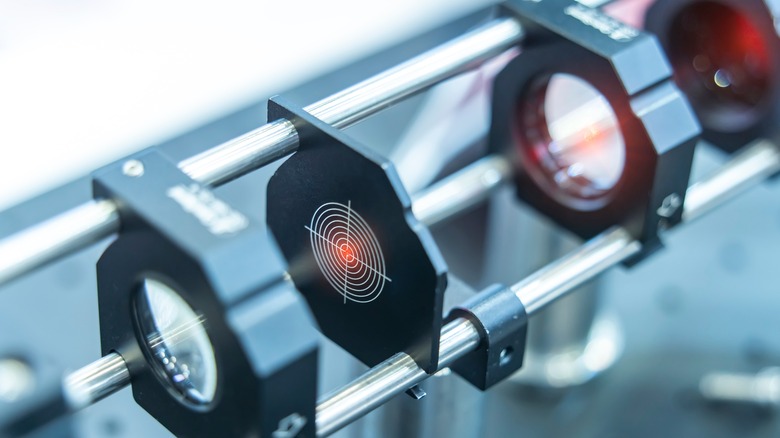This Future Laser Technology Could Be The Key To Terraforming Mars
It's no secret that NASA is planning on sending people to Mars, but for now, they're mostly focused on astronauts. If you have dreams of permanent Martian settlements where average folks work and play and live out their lives, we're going to have to tidy up the place first. It's called terraforming: turning the dry, frozen hellscape of another celestial body into something Earthlike. And according to a new video by Kurzgesagt, it's totally doable! But we're going to need a giant laser.
When we say giant laser, we mean way more than whatever you're imagining. The most powerful laser in the world today is the High Power Laser System (HPLS) in Romania, which can fire a 10 petawatt beam for less than a trillionth of a second (via Laser Focus World). For reference, a typical refrigerator uses about 225 watts, so 10 petawatts could power close to — let's see, carry the two — four and a half trillion refrigerators (which could hold a heck of a lot of leftover pizza, but that's beyond the scope of this project).
Now, that's just the HPLS. To terraform Mars, we would need a laser twice as powerful, and instead of firing for a tiny fraction of a second, it would need to run nonstop. For 50 years. So, is that the whole roadmap to terraforming Mars? Sadly, no. That's just the first step. Our ridiculously powerful laser has a lot more left to do.
Are we there yet?
Turning a dead space rock into a comfortable summer home for humanity isn't like flipping a house, as explained in a video published by Kurzgesagt. Mars has no surface water to support life; the thin atmosphere hardly has any oxygen; the surface doesn't contain the nutrients needed to grow plants. As it turns out, though, many of these problems can be remedied by melting the planet's surface to release needed chemicals trapped in rocks. That first step outlined above would melt Mars' entire surface down to the depth of a typical two-story house, and it would get us all the oxygen we'd need.
This would cause some wacky weather for a while, like steaming ice caps and iron snow. Oh, and don't forget the blindingly bright lava flows. Even though it would release massive amounts of oxygen, the atmosphere itself would be dangerously flammable and still thinner than the air atop Mount Everest. Even so, it's a good start.
All that would be left to do is import three quadrillion tons of nitrogen, pulverize the newly-cooled volcanic rock surface into powder, introduce a balanced and self-sustaining food web from bacteria and algae up through plants and animals (which has been a struggle here at home), and then somehow deflect the solar and cosmic radiation because — oh yeah — Mars doesn't have Earth's protective magnetic field. You can see all the details for yourself in the wonderful video above. It's really as simple as that, so we're not sure what the skepticism's about, Neil deGrasse Tyson.
